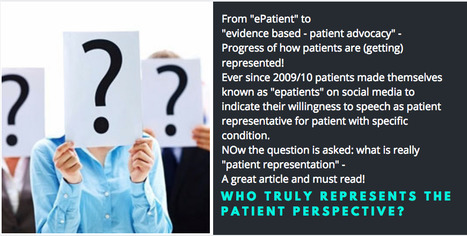Who truly represents the patient perspective?
By Simon Crompton
In CancerWorld September / October 2016 2016, 18-21.
As researchers, regulatory bodies and health systems give patients more of a voice in consultation and decision making, advocacy groups are questioning what it really means to represent the patient view.
Nothing about us without us. So goes the mantra of patient organisations around the world, asserting their right to have a say in health decision-making.
Five words that make patient involvement sound so simple. But a growing body of patient and cancer organisations are asserting that it’s anything but simple: the whole idea of ‘patient representation’ is flawed and needs a re-think, they say.
Conventional models of patient representation bring risks. For some committees, companies and organisations, having a patient on the panel simply means they can tick the patient involvement box and move on. At least that’s the view of Deb Maskens, founder of Kidney Cancer Canada and Vice Chair of the International Kidney Cancer Coalition (IKCC).
“It’s far too easy for health technology assessment organisations or pharmaceutical companies to say that they have a patient on their committee and therefore they have had patient input,” she says. [..]
And then there’s the question of how ‘representative’ patient ‘representatives’ can actually be. Several European patient organisations have become concerned about the number of committees where one or two firmly established patients are there to represent all cancer patients – even in discussions that relate to a type or stage of cancer entirely different from their own. That situation, says Maskens, is “absolutely ludicrous”.
Bettina Ryll, founder of the Melanoma Patient Network Europe, Chair of ESMO’s patient advocacy working group and a patient representative on many committees, agrees. As long as patients on committees are expected to represent the views of hundreds of people whose experiences may be entirely different from their own, they are in a very vulnerable and ineffective position.
“It’s very very difficult to be representative. I’m fed up with being challenged about this wherever I go. People say: ‘Yes, but how representative are you anyway?’ and this is a very easy way to take out the patient perspective if it’s not convenient. It’s an especially pressing issue because not everyone in health systems is happy with patient voices becoming more integrated into health decision-making. Undermining difficult patient views happens very frequently, and in the end, just the ‘yes-sayers’ are left over. That’s not sufficient.”
Those who represent patient interests in complex technical discussions are also vulnerable to criticism. Discussions on the relative risks and benefits of specific drugs, for example, may require some expert knowledge from the patient representative. But people with that degree of understanding are then accused of no longer being representative of most patients. “It’s a double bind,” says Ryll. “You can’t win.”
Evidence-based advocacy
But there may be a way forward. A growing number of patient advocacy groups are adopting the idea of ‘evidence-based advocacy’ to replace conventional ideas of ‘representation’. It involves letting go of any expectation that one patient should be able to represent everyone. Instead, patients on groups or committees gather, filter and convey information about the patient perspective on a particular issue from a variety of sources. They become a conduit for evidence from the relevant patient community, not a narrator of personal experience or opinion.
“I don’t in any way want to take away from the value of people conveying their personal narratives,” says Maskens. “But patient representatives now need to be equipped with a new skill set.
“Those on established committees should have to have an ear to the ground of what is happening in that disease space. There are thousands of people online in some form, and so before a review decision comes up, patient representatives can take a deeper dive into that patient community – listening to them, asking open-ended questions.
Read on... ! HERE
Via rob halkes



 Your new post is loading...
Your new post is loading...









From "ePatient" up to "evidence-based patient advocacy: Progress is seen in how patient are (getting) represented. Ever since 2009/10 some patients made themselves known as "epatients" on social media to indicate their willingness and drive to speak as representative of patients with a specific condition.
Patient Advocacy groups took up this idea and forwarded patients among their midst. "Patients Inside" became a certificate for conferences in which participation of patients was organised and guaranteed. The idea is now introduced to use the term "evidence based" patient advocacy in which "representatives" "hear" their peers about some issue of interest and then forward the "data" to meaningful information for whoever wants to know.. It is a positive add on to the skills and channels patients have to forward their opinions, experiences and preferences!
From "ePatient" up to "evidence-based patient advocacy: Progress is seen in how patient are (getting) represented. Ever since 2009/10 some patients made themselves known as "epatients" on social media to indicate their willingness and drive to speak as representative of patients with a specific condition.
Patient Advocacy groups took up this idea and forwarded patients among their midst. "Patients Inside" became a certificate for conferences in which participation of patients was organised and guaranteed. The idea is now introduced to use the term "evidence based" patient advocacy in which "representatives" "hear" their peers about some issue of interest and then forward the "data" to meaningful information for whoever wants to know.. It is a positive add on to the skills and channels patients have to forward their opinions, experiences and preferences!